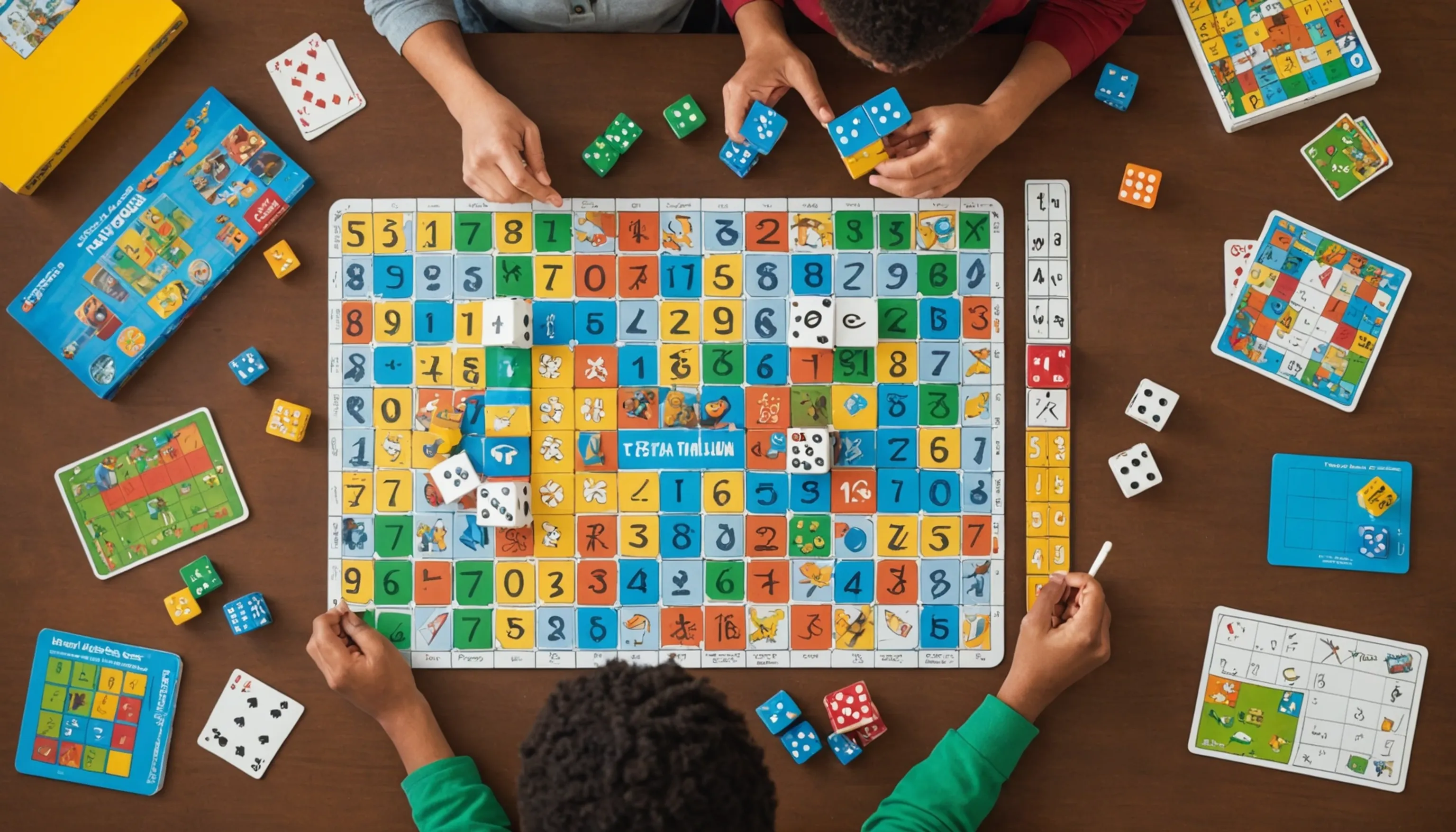Using Games to Make Math Learning Engaging
 HvWHenry van Wagenberg
HvWHenry van Wagenberg
Using Games to Make Math Learning Engaging
Using games to make math learning engaging can transform the way teenagers perceive mathematics. Incorporating playful elements into lessons not only enhances motivation but also fosters a deeper understanding of mathematical concepts. Games can provide instant feedback, allowing students to learn from their mistakes in a low-pressure environment.
Moreover, they encourage collaboration and communication among peers, which is essential for developing problem-solving skills. By blending learning with fun, educators can create a vibrant classroom atmosphere where students are eager to participate and explore mathematical ideas.
Benefits of Game-Based Learning in Math
Game-based learning in math offers numerous benefits that can significantly enhance students' educational experiences. One of the primary advantages is increased engagement. When students participate in math games, they are more likely to be motivated and enthusiastic about learning, as games create an enjoyable atmosphere. This heightened interest helps reduce math anxiety, which many teenagers face.
Moreover, game-based learning promotes active participation. Students are often more involved in the learning process when they can interact with the material in a hands-on way. This leads to improved retention of mathematical concepts, as they are more likely to remember what they have actively engaged with.
Another critical benefit is the development of critical thinking skills. Many math games require players to solve problems, strategize, and make decisions, fostering essential cognitive abilities. This kind of learning encourages students to think creatively and approach math from different angles, which enhances their overall problem-solving skills.
Additionally, game-based learning can facilitate collaboration among students. Many games encourage teamwork, allowing students to work together to solve problems and share strategies. This not only improves their social skills but also helps them learn from one another, creating a supportive learning environment.
Finally, game-based learning allows for differentiated instruction. Teachers can tailor games to meet the varying needs of their students, ensuring that everyone can participate and benefit from the learning experience.

Types of Math Games for Teenagers
There are several exciting types of math games designed specifically for teenagers that cater to different learning styles and objectives. These games can be categorized into various formats, each serving a unique purpose in enhancing math skills.
1. **Board Games**: Traditional board games with a math twist can be incredibly engaging. Games like Monopoly or Math Bingo can reinforce arithmetic skills while providing a fun, competitive environment.
2. **Online Math Games**: Websites and apps offer interactive math games that appeal to tech-savvy teens. Platforms like Kahoot! or Prodigy allow students to practice math in a dynamic and visually appealing way, often featuring levels and rewards.
3. **Card Games**: Card games such as Math War or 21 can be adapted to reinforce concepts like addition, subtraction, and even probability. These games promote quick thinking and mental math skills.
4. **Puzzle Games**: Puzzles like Sudoku or logic puzzles challenge students' critical thinking and problem-solving abilities, which are essential for mastering mathematical concepts.
5. **Role-Playing Games (RPGs)**: RPGs can integrate math through quests and challenges that require calculations or resource management, making math relevant to real-life scenarios.
By incorporating a mix of these game types into math learning, educators can create a more stimulating and effective educational experience for teenagers, catering to their diverse interests and learning preferences.
How to Incorporate Games into Math Curriculum
Incorporating games into the math curriculum can revitalize learning and foster student engagement. Start by identifying key mathematical concepts that can be enhanced through games, such as fractions, algebra, or geometry. Choose games that align with your curriculum objectives, ensuring they reinforce specific skills.
Integrate these games into lessons by using them as warm-up activities, centers, or group challenges. Encourage collaboration by having students work in teams to solve problems or compete in friendly matches. Additionally, consider setting aside dedicated time each week for game-based learning, allowing students to explore math concepts in a fun, interactive way.

Setting Learning Objectives with Games
Setting learning objectives when incorporating games into math education is crucial for ensuring that students gain valuable skills while having fun. Clear objectives provide a framework for both teachers and students, guiding the learning process and allowing for effective assessment.
First, identify the specific math skills you want to target with a game. For instance, if you're focusing on algebra, your objective might be to improve students' ability to solve linear equations. This clarity helps in selecting the right game that aligns with your goals.
Next, consider the cognitive level of your students. Objectives should be tailored to challenge them appropriately, whether they are beginners or advanced learners. For example, a game designed for basic arithmetic should aim for fluency in addition and subtraction, while a more advanced game might focus on applying concepts in problem-solving scenarios.
Incorporate measurable outcomes into your objectives. Instead of stating that students will "understand fractions," specify that they will be able to "accurately add and subtract fractions with like denominators in at least 80% of attempts." This measurable approach allows you to track progress effectively.
Finally, involve students in the objective-setting process. Discussing goals with them can enhance ownership and motivation. When students understand what they are expected to learn and how games will help achieve those objectives, they are more likely to engage meaningfully in their learning experience.
Choosing the Right Games for Different Math Topics
Selecting the right games for various math topics is essential for effective learning and engagement. Different mathematical concepts require distinct approaches, and the right game can make all the difference in helping students grasp these ideas.
Start by aligning games with the specific math topics you wish to cover. For instance, for teaching geometry, consider games that involve shape identification and spatial reasoning, such as Shape Sorter or online interactive platforms that allow students to manipulate shapes. These types of games encourage hands-on exploration and help solidify geometric concepts.
For algebra, look for games that focus on solving equations or manipulating variables. Games like Algebra Tiles provide a tactile way for students to visualize and solve algebraic expressions, making abstract concepts more tangible.
When addressing probability and statistics, opt for games that involve data collection and analysis, such as Probability Puzzles or card games that require players to calculate odds. These games can help students understand real-world applications of probability.
Lastly, consider the interests and skill levels of your students. Choose games that not only align with the math topic but also engage them based on their preferences, whether they enjoy competition, collaboration, or strategy. By thoughtfully selecting games that cater to specific math topics, you can create a dynamic and effective learning environment that resonates with students.
Tips for Parents and Teachers
Here are some useful tips for parents and teachers looking to incorporate games into math learning:
- Choose age-appropriate games: Ensure that the games match the skill level and interests of the students.
- Set clear objectives: Define what math skills or concepts you want students to learn through the games.
- Encourage teamwork: Promote collaboration by having students work together, fostering communication and problem-solving skills.
- Monitor progress: Assess students' understanding after playing games to ensure learning objectives are met.
- Make it fun!: Keep the atmosphere light and enjoyable to maintain student engagement.
Creating a Balanced Approach to Game Time
Creating a balanced approach to game time in math education is essential for maximizing the benefits while ensuring that learning objectives are met. While games can enhance engagement and understanding, it's crucial to integrate them thoughtfully within the overall curriculum.
First, establish a clear framework for game time. Determine how much time will be allocated for games each week, ensuring it complements traditional instruction rather than replacing it. For example, dedicating one lesson per week to game-based learning can provide students with the opportunity to apply concepts in a fun environment without compromising core content.
Next, align game activities with specific learning objectives. Before introducing a game, clarify which skills or concepts students will practice. This helps maintain focus and ensures that the game serves an educational purpose. For instance, if the objective is to improve multiplication skills, select games that specifically target this area.
Additionally, monitor student engagement and progress during game time. Collect feedback from students about their experiences and observe how they interact with the games. This information can guide future selections and adjustments to game time, ensuring that it remains effective and enjoyable.
Finally, consider balancing competitive and collaborative games. While competition can motivate some students, others may thrive in cooperative settings. By offering a mix of both, you can cater to diverse learning preferences and foster a supportive classroom environment. Ultimately, a balanced approach to game time will enhance the overall learning experience in math education.
Monitoring Progress and Engagement
Monitoring progress and engagement during game-based learning in math is vital for ensuring that students are not only enjoying themselves but also effectively mastering essential concepts. A structured approach to tracking both aspects can help educators make informed decisions about instructional strategies.
Start by establishing clear criteria for success. Define what progress looks like for each game or activity, such as accuracy in solving problems or improvement in speed. This will provide a benchmark against which student performance can be measured. Use assessment tools like quizzes or observational checklists to gauge understanding before and after game sessions.
Next, engage students in self-assessment. Encourage them to reflect on their learning experiences by asking questions like, “What did you learn today?” or “How did you solve that problem?” This practice not only fosters metacognition but also helps students take ownership of their learning journey.
Additionally, maintain open communication with students about their engagement levels. Regularly solicit feedback on the games being played—do they find them challenging, fun, and relevant? This information is invaluable for refining the selection of games and ensuring that they continue to capture student interest.
Finally, create a system for tracking progress over time. Consider using a digital platform or a simple spreadsheet to record data on student performance and engagement. This will allow you to identify trends, celebrate achievements, and address any areas where students may be struggling, ensuring a dynamic and responsive learning environment.
